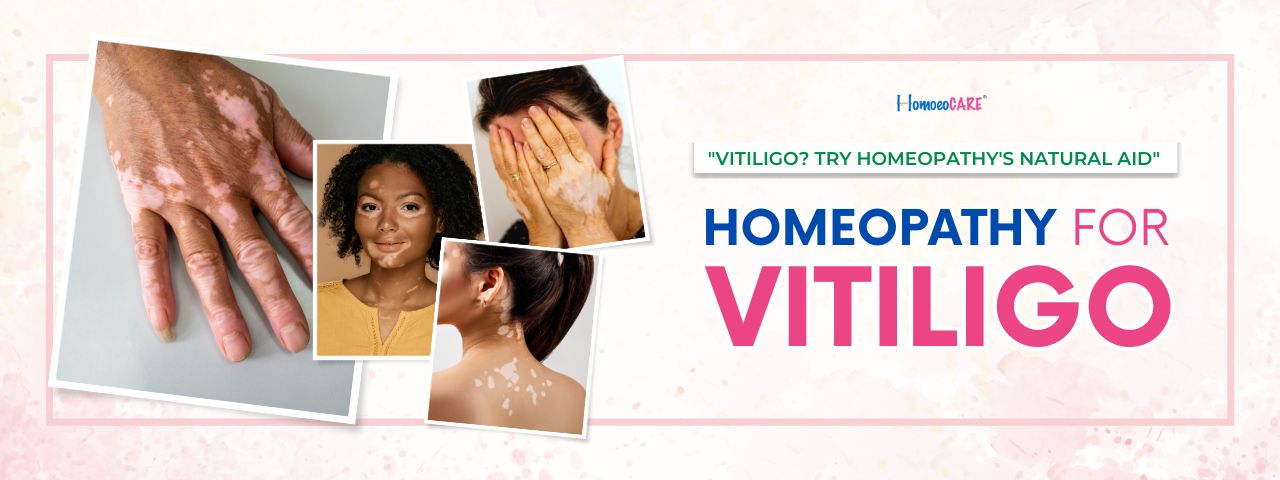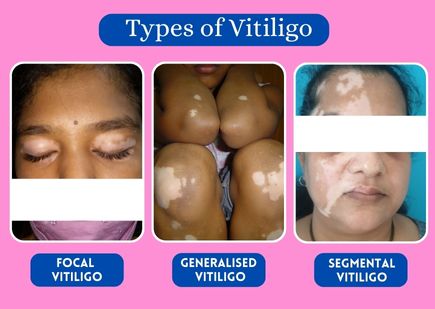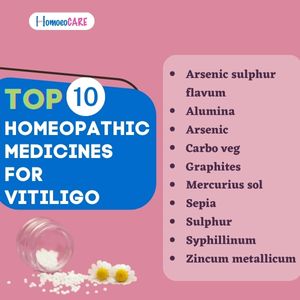
White patches on face?
White patches on skin?
This article will explain what is vitiligo, what are the causes of Vitiligo? And what is the best homeopathic treatment for Vitiligo?
Vitiligo is a chronic skin condition characterized by the selective loss of functional melanocytes, the pigment-producing cells in the skin. This results in the development of depigmented or hypopigmented patches, commonly presenting as white or light-colored areas on the skin
Melanocytes are specialized cells found in the skin, hair follicles, eyes, inner ear, and other tissues of the body. These cells play a crucial role in producing and distributing melanin, the pigment responsible for determining the color of our skin, hair, and eyes. In vitiligo these Melanocytes which give color to the skin are lost, resulting in white patches.
1. Depigmented Patches: The hallmark symptom of vitiligo is the presence of white or light-colored patches on the skin. The color contrast between the affected areas and the surrounding normal skin may be quite noticeable.
2. Symmetrical Distribution: Vitiligo often affects both sides of the body symmetrically, meaning that if a patch develops on one side, a similar patch is likely to develop on the corresponding area on the other side.
3. Hair Color Changes: The loss of melanin in the hair follicles can result in white or grey hair within or around the depigmented patches.
4. Involvement of Mucous Membranes: In some cases, vitiligo may affect mucous membranes, such as the tissues inside the mouth or nose, leading to depigmentation in these areas.
5. Eye Involvement: Rarely, vitiligo can affect the eyes, leading to changes in pigmentation in the retinal pigment epithelium. This is more common in individuals with certain types of vitiligo.
6. Photosensitivity: Individuals with vitiligo may experience increased sensitivity to sunlight in the depigmented areas. Sunburn may occur more easily in these areas, emphasizing the importance of sun protection.
Vitiligo can affect people of all races and ethnicities, and it occurs worldwide. It can manifest at any age, but its onset often occurs in individuals under the age of 20. The condition exhibits a variable and unpredictable progression, affecting diverse body regions. While vitiligo itself does not pose physical health risks, the visible nature of the depigmented patches can have notable psychosocial implications for affected individuals.
.jpg)
The cause of vitiligo is multifaceted and not fully elucidated, involving a complex interplay of genetic, autoimmune, and environmental factors. Autoimmune mechanisms are thought to contribute significantly, as the immune system targets and attacks melanocytes, leading to their destruction or functional impairment.
The exact cause of Vitiligo is not known. However, several factors may contribute to the development of vitiligo.
Genetics: There appears to be a genetic component to vitiligo. If someone in your family has vitiligo, you may be at a higher risk of developing the condition. However, the inheritance pattern is complex, and not everyone with a family history of vitiligo will develop the condition.
Autoimmune Disorders: Vitiligo is considered an autoimmune disease. What happens in vitiligo is that the body’s immune system is triggered against the melanocytes and it starts attacking the melanocytes and destroying them. In autoimmune conditions, the immune system mistakenly attacks and destroys the body's own cells, including melanocytes (the pigment-producing cells), leading to the loss of pigmentation in the skin. Individuals with other autoimmune disorders may have an increased risk of developing vitiligo.
Age and Gender: Vitiligo can develop at any age, but it often begins before the age of 20. It affects both genders equally, and all ethnic groups, although it may be more noticeable in people with darker skin due to the contrast between depigmented and pigmented areas.
Environmental Factors: Some environmental factors, such as exposure to certain chemicals, critical sunburns, or emotional distress. Trauma to the skin, such as cuts or burns, is also considered a potential trigger and may play a role in the development of vitiligo. However, these factors are not fully understood, and research is ongoing.
Neural Causes: Some theories suggest a connection between neural factors and the development of vitiligo. Trauma or dysfunction in the nervous system may influence the activity of melanocytes, contributing to depigmentation.
Stress: Stress is sometimes associated with the onset or exacerbation of vitiligo in some individuals. Emotional stress or trauma may be a triggering factor for the development of vitiligo in susceptible individuals.
Individuals with certain autoimmune disorders may have a higher risk of developing vitiligo. Some of the autoimmune conditions that are often associated with vitiligo include:
1. Autoimmune Thyroid Disorders:
• Hashimoto's thyroiditis: An autoimmune condition affecting the thyroid gland.
• Graves' disease: Another autoimmune thyroid disorder that leads to hyperthyroidism.
2. Type 1 Diabetes:
• This autoimmune condition involves the destruction of insulin-producing beta cells in the pancreas.
3. Rheumatoid Arthritis:
• An autoimmune disorder that primarily affects the joints.
4. Addison's Disease:
• An autoimmune disorder affecting the adrenal glands, leading to insufficient production of certain hormones.
5. Pernicious Anemia:
• An autoimmune condition characterized by the inability to absorb vitamin B12, which is necessary for red blood cell production.
6. Systemic Lupus Erythematosus (SLE):
• A chronic autoimmune disease that can affect various organs and tissues.
The causes of vitiligo may differ among individuals; that's why homeopathic treatment for vitiligo is ideal for Vitiligo. Homeopathy understands the physical and emotional aspects of patients, unlike conventional treatment that only focuses on signs and symptoms
When no melanin is produced, the involved patch of skin becomes white. The exact cause is unknown, but it may be related to immune disorders, heredity, or environmental factors such as sunburn or emotional distress.

Non-segmental vitiligo, affecting about 90% of those with Vitiligo, is the most common type. It often manifests symmetrically on both sides of the body and can affect various body parts exposed daily to sunlight.
Preventive measures include the use of sunscreen to protect the skin from sunburn and minimize tanning, reducing the contrast between normal and depigmented skin. Cosmetics such as stains, makeup, or self-tanning lotions may be used to cover depigmented patches.
Restrict the following foods
Lower Intake (can take once/twice a week)
Add Diet
There are numerous Homeopathic medicines for vitiligo. However, these are the top 10 homeopathic medicines for vitiligo.
1. Arsenic sulphur flavum
2. Alumina
3. Arsenic
4. Carob veg
5. Graphites
6. Mercurius sol
7. Sepia
8. Sulphur
9. Syphillinum
10. Zincum metallicum
These are just a few indicated homeopathic medicines for vitiligo. A piece of advice from a homeopathic doctor for vitiligo is always recommended to achieve the best homeopathic treatment for vitiligo.

Homeopathic approaches for managing Vitiligo involve holistic methods that consider the individual's overall health. Specific remedies may be recommended based on the person's symptoms, constitution, and the nature of Vitiligo.
White patches result when melanocytes producing melanin are lost or is atrophied. In modern medicine there is no cure for Vitiligo except by managing it with steroidal ointments. Whereas Homeopathic Treatment For Vitiligo stimulates the functioning of melanocytes, which results in proper secretion of melanin thereby normal skin color returns without any side effects.)
While conventional treatments focus on managing it with immuno-suppressants, homeopathy offers a more holistic approach. By stimulating melanocyte function, homeopathic medicine for vitiligo can restore natural skin color without side effects.
An 8-year-old girl named Miss KJ from Kurla, Mumbai, visited HomoeoCARE for homoeopathic treatment for Vitiligo. After starting the treatment, within a few months, no new spots appeared, and over two years, the white patches regained their original color, disappearing completely. Similarly, a 17-year-old lady with Vitiligo for 8 years, underwent homoeopathic treatment and experienced no new spots. Within a year, all patches vanished, achieving a Vitiligo-free status solely through homoeopathic treatment.
Vitiligo can appear at any age, but it often first manifests between 20 and 30 years.
No, Vitiligo is non-contagious.
Focal and segmental patterns usually do not spread, while the generalized pattern can be unpredictable and may randomly stop.
Triggers can include autoimmune disorders, genetic factors, skin trauma, and exposure to chemicals, sunburn, emotional distress, and heredity.
Diagnosis may involve medical screenings, including family history, skin trauma assessment, premature graying of hair, stress, or physical illness. Eye examinations and blood tests may also be conducted.
If you have any queries regarding your disease or any symptoms, Click here to send a WhatsApp message. Our doctors will be happy to answers these.
If you have any queries regarding your disease or any symptoms, Click here to send a WhatsApp message. Our doctors will be happy to answers these.
If you want to visit our clinic, Click here to book an appointment.
If you are a busy professional, or you are living in a remote town or city, with no best homeopathic doctor near you, Click here to start an online homeopathic treatment with the world's exclusive and only specialized pediatric homeopathic clinic, managed by Dr. Pravin Jain world-renowned homeopathic pediatric expert.
Copyright ©2021 Homoeocare